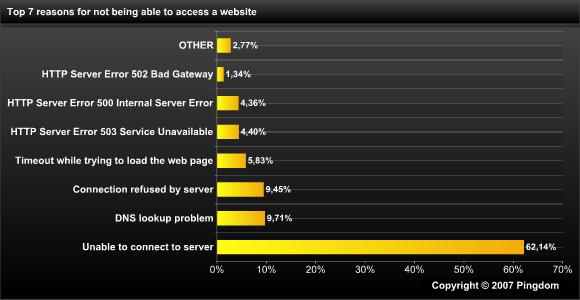Who hasn’t had a problem accessing a website on the internet? Our guess is that there isn’t anyone out there who has had an error-free experience of the web. But what are the main reasons for all these problems? We decided to find out.
Since Pingdom is a website monitoring service with thousands of customers in 127 countries, we have a lot of data. By summarizing the results of more than 160 million website tests we were able to find seven types of errors that make up more than 97% of all website problems.
Why is this useful to know? Aside from the geek factor of this knowledge, webmasters and network administrators can benefit from knowing what the most common website problems are so they know what to look out for the most. We hope this report will be helpful.

Top 7 errors with explanations
These seven errors together constitute more than 97% of the cases when a website is not working. We have listed them here together with brief explanations and some of the possible reasons behind the errors.
-
- 62.14% – Unable to connect to server
The connection attempt to the web server times out.
Possible reasons: Server is down or unreachable (which can be network related, or a firewall issue). Web server software is down or overloaded. - 9.71% – DNS lookup problem
The domain name of the website could not be resolved.
Possible reasons: Incorrect settings and/or configuration of the DNS servers for the domain name of the website. - 9.44% – Connection refused by server
The web server responds but refuses a connection.
Possible reasons: Overloaded web server or other internal server problem. - 5.83% – Timeout while trying to load the web page
A connection was established, but the HTML page load times out.
Possible reasons: Overloaded web server or network/internet connection. - 4.40% – HTTP Server Error 503 Service Unavailable
The web server is temporarily unable to handle the request.
Possible reasons: Overloaded or broken web server software. - 4.36% – HTTP Server Error 500 Internal Server Error
This is a general error message from the web server that it has encountered an internal problem.
Possible reasons: Internal server error. Hard to be specific here. - 1.34% – HTTP Server Error 502 Bad Gateway
A server acting as a gateway or proxy for a web server was unable to fulfil the request.
Possible reasons: Web server down or web server software down. Communication problem between gateway and web server.
- 62.14% – Unable to connect to server
Conclusion
Anytime you access a website, there is a lot on the way that can go wrong. Now you know the seven most common reasons. This report shows that the most common problem by far is simply not being able to reach the server at all, which is often a network-related problem. DNS-related issues also need to be taken into account, as well as server load issues. These three factors together account for more than 80% of all website problems.
How the report was created
Pingdom is a server and website monitoring service that monitors many thousands of websites. We went through the monitoring results for all the websites monitored by our customers (our HTTP checks) and extracted every single error reported from all of our monitoring servers. We took data from the last 30 days, which contains more than 160 million test results.


























